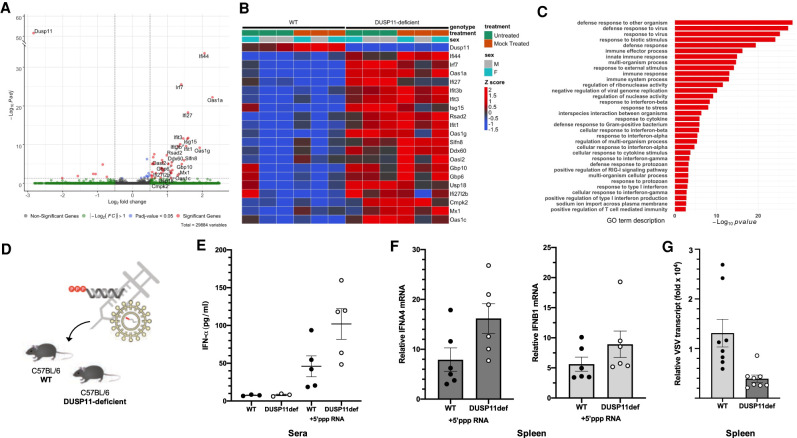Figure 6.
Mice lacking DUSP11 display an enhanced signature of interferon signaling. Transcriptomic analysis was performed on liver samples collected from age/sex pair-matched DUSP11-deficient (n = 6 mice: n = 3 male, n = 3 female) versus wild-type mice (n = 6 mice: n = 3 male, n = 3 female). Data were generated from two experiments: untreated (n = 3 mice: n = 2 male, n = 1 female) and mock-treated (n = 3 mice: n = 1 male, n = 2 female) conditions. Combined data were modeled controlling for sex and experiment-treatment (based on Supplemental Fig. S8A) using DESeq2. (A) Volcano plot of differentially expressed genes between DUSP11-deficient mice versus wild-type mice. (B) Heat map of differentially expressed genes up-regulated between DUSP11-deficient mice versus wild-type mice. (C) Analysis of gene ontology (GO) biological process terms enriched for genes up-regulated between DUSP11-deficient versus wild-type mice. (D) Schematic diagram of the VSV 5′-ppp PAMP RNA in vivo transfection assay and VSV infection assay. DUSP11-deficient (DUSP11def) and wild-type (WT) mice were either treated with in vitro transcribed VSV 5′-ppp PAMP RNA (intraperitoneal injection, 15 μg) or infected with WT VSV (intravenous tail vain injection, 2 × 106 PFU). Sera and tissue samples were harvested 6 h posttreatment. (E) ELISA analysis of sera IFN-α levels from VSV 5′-ppp PAMP RNA or mock-treated mice. Sera were collected from age/sex pair-matched DUSP11-deficient (n = 3 mice: n = 1 male, n = 2 female for mock, and n = 5 mice: n = 3 male, n = 2 female for VSV 5′-ppp PAMP RNA-treated) and wild-type (n = 3 mice: n = 1 male, n = 2 female for mock, and n = 5 mice: n = 3 male, n = 2 female for VSV 5′-ppp PAMP RNA-treated) mice. (F) RT-qPCR analysis of IFNA4 and IFNB1 mRNA normalized to GAPDH mRNA in spleen RNA from VSV 5′-ppp PAMP RNA-treated mice. RT-qPCR results are presented relative to those of mock-treated mice. Spleen samples were collected from age/sex pair-matched DUSP11-deficient (n = 6 mice: n = 4 male, n = 2 female) and wild-type (n = 6 mice: n = 4 male, n = 2 female) mice. (G) RT-qPCR analysis of VSV transcript normalized to GAPDH mRNA in spleen RNA from VSV-infected mice. RT-qPCR results are presented relative to those of mock-treated uninfected mice. Spleen samples were collected from age/sex pair-matched DUSP11-deficient (n = 8 mice: n = 3 male, n = 5 female) and wild-type (n = 8 mice: n = 3 male, n = 5 female) mice. Data are presented as mean ± SEM.

